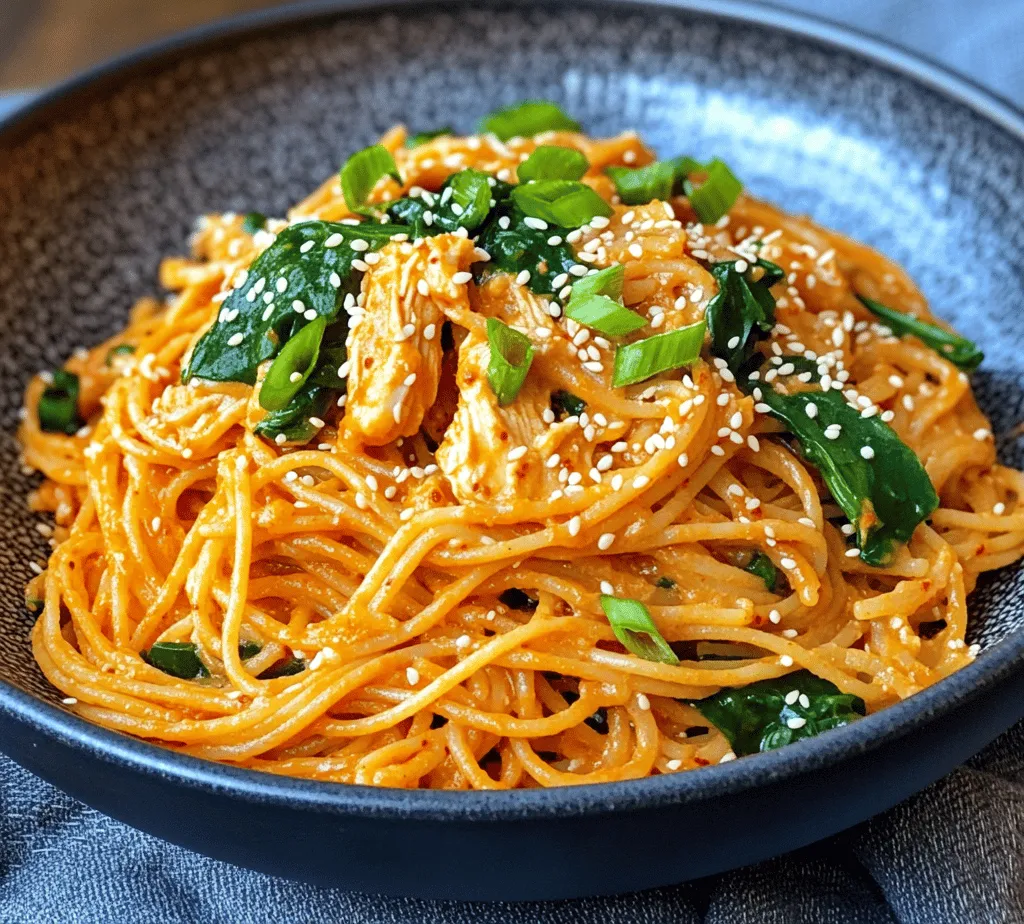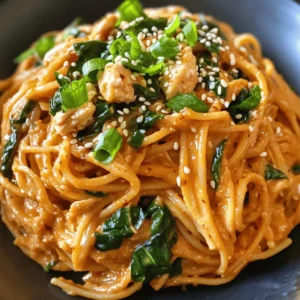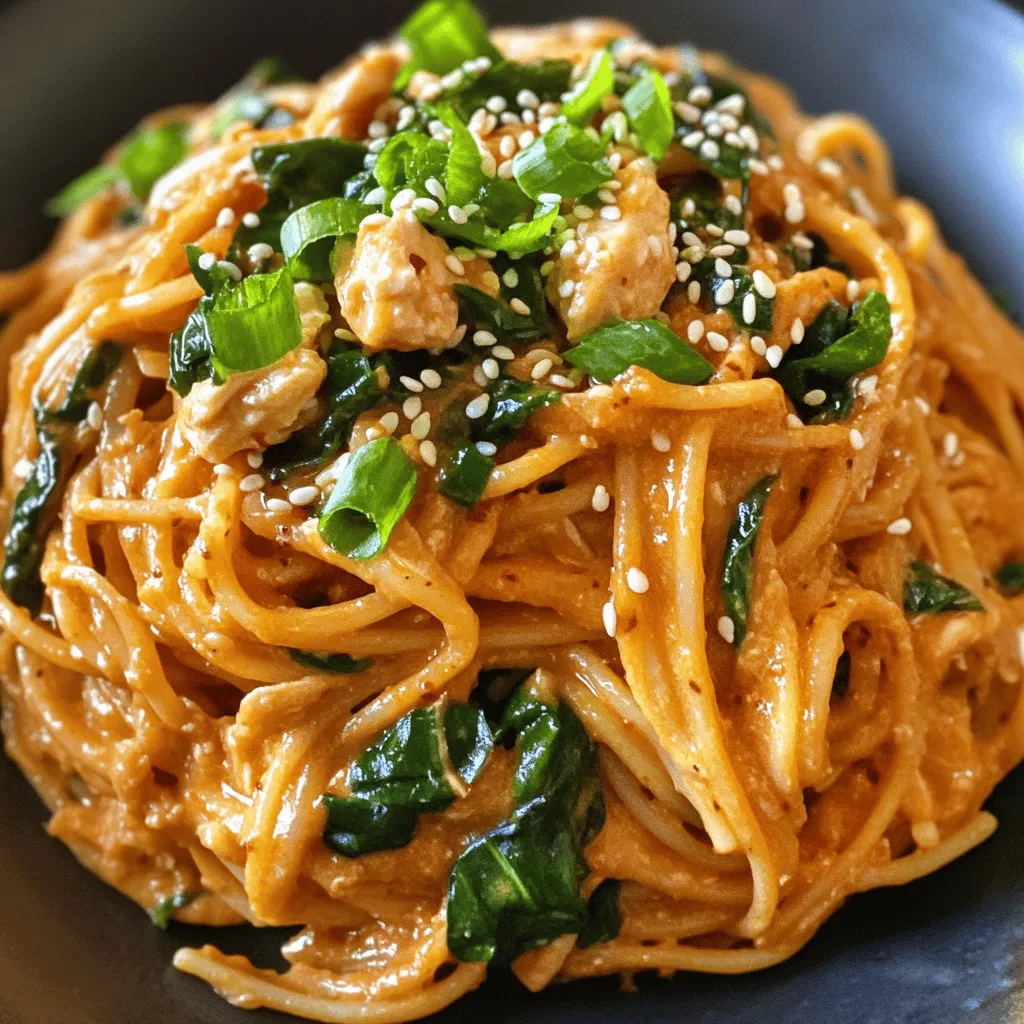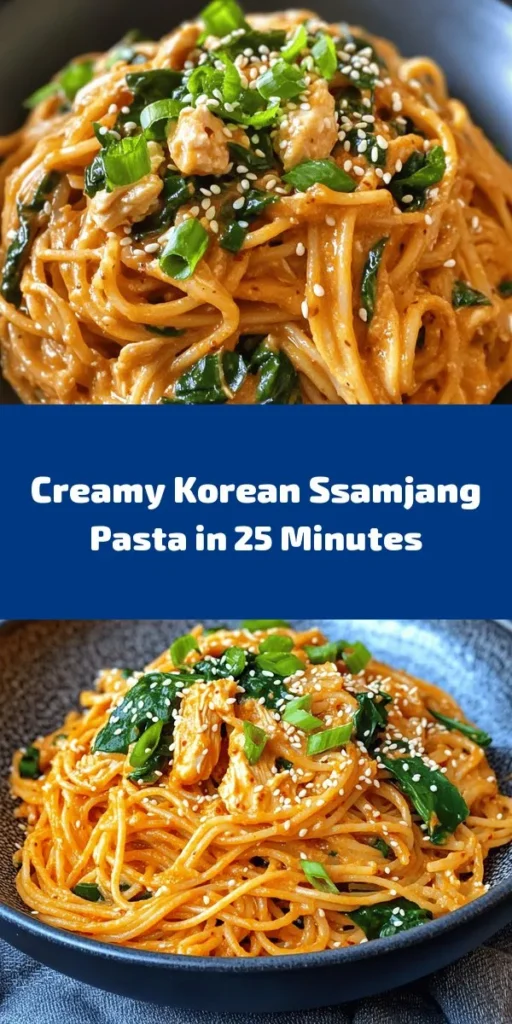Introduction
In the world of culinary arts, fusion cuisine has gained immense popularity for its ability to blend flavors and ingredients from different cultural backgrounds. One such exciting fusion creation is the Creamy Korean Ssamjang Pasta, which harmoniously marries the rich, creamy texture of Italian pasta with the spicy, umami-packed essence of Korean ssamjang. This dish is not just a feast for the taste buds but also a reflection of how diverse culinary traditions can come together to create something entirely new and delicious.
The unique combination of flavors in Creamy Korean Ssamjang Pasta makes it a delightful choice for food enthusiasts looking to try something different. The creamy base, enhanced by the distinctive kick of ssamjang, offers a comforting yet exhilarating dining experience. Whether you’re aiming to whip up a quick meal on a busy weeknight or impressing guests with an innovative dish at your next dinner party, this recipe is both easy to prepare and sure to leave a lasting impression.
Understanding Ssamjang
At the heart of this flavorful fusion dish lies ssamjang, a traditional Korean dipping sauce that boasts a rich history and a unique flavor profile. Originating from Korea, ssamjang is primarily made from two key ingredients: fermented soybean paste (doenjang) and chili paste (gochujang). These ingredients are carefully blended with additional seasonings, often including garlic, sesame oil, and green onions, to create a thick, savory paste that is commonly used to enhance the flavor of various dishes, including grilled meats and vegetables.
The flavor profile of ssamjang is truly remarkable, as it delivers a perfect balance of savory, spicy, and slightly sweet notes. The fermented soybean paste contributes umami depth, while the chili paste adds a satisfying heat that can be adjusted according to personal preference. This versatility makes ssamjang an excellent addition to a wide range of recipes, including our Creamy Korean Ssamjang Pasta.
In addition to its delicious taste, ssamjang is also rich in health benefits. The fermentation process involved in making doenjang and gochujang introduces probiotics, which can promote gut health, aid digestion, and enhance the immune system. Furthermore, the ingredients in ssamjang are packed with antioxidants, making it a flavorful option that also supports overall health.
Pasta: The Perfect Base
When it comes to the backbone of this dish, pasta plays a crucial role in delivering the creamy ssamjang sauce to your palate. For this recipe, we’ll focus on using spaghetti, a classic pasta choice that pairs beautifully with the rich and creamy sauce. The long, thin strands of spaghetti allow for even coating with the sauce, ensuring that every bite is infused with flavor.
However, it’s important to note that this recipe is versatile, and you can use various types of pasta, depending on your preference. Penne, fettuccine, or even gluten-free pasta options can be substituted without compromising the dish’s integrity. If you’re looking for a gluten-free alternative, consider using chickpea pasta or brown rice pasta, both of which provide a satisfying texture while accommodating dietary restrictions.
To achieve the perfect al dente pasta, it’s essential to follow a few simple tips. Start by bringing a large pot of salted water to a boil before adding the pasta. The salt not only enhances the flavor of the pasta but also helps in achieving a firmer texture. Cook the spaghetti according to the package instructions, usually around 8-10 minutes, but be sure to taste a strand a minute or two before the time is up. You want the pasta to be tender yet firm to the bite.
Once cooked, remember to reserve a cup of the pasta water before draining. This starchy water can be a valuable addition to the sauce, helping to thicken it and ensuring that it clings beautifully to the pasta. After draining, toss the spaghetti with a drizzle of olive oil to prevent it from sticking while you prepare the creamy ssamjang sauce.
Ingredients Breakdown
Heavy Cream
The cornerstone of our creamy sauce is heavy cream, which contributes to the rich, velvety texture that coats the pasta. Heavy cream is ideal for creating a luxurious sauce that balances the spiciness of the ssamjang. If you’re looking for alternatives due to lactose intolerance or dietary preferences, consider using coconut cream or cashew cream for a dairy-free option. These alternatives can provide a similar creaminess, allowing everyone to enjoy this dish.
Sesame Oil
Next on our ingredient list is sesame oil, a key player in adding depth and flavor to the dish. With its nutty aroma and rich taste, sesame oil elevates the overall profile of the pasta. If you find yourself without sesame oil, you can substitute it with olive oil or avocado oil, though the distinctive flavor of sesame oil may be missed.
Garlic and Onion
Garlic and onion are fundamental aromatics that play an essential role in building flavor. Sautéing these ingredients until they are soft and fragrant creates a savory foundation for the sauce. The sweetness of the sautéed onion and the pungent aroma of garlic will enhance every bite of the pasta. For a milder flavor, consider using shallots instead of onions, or for added heat, minced shallots can be a great option.
Optional Chicken
For those looking to add protein to their dish, cooked chicken can be included. Sautéing diced chicken breast alongside the garlic and onion creates a heartier meal that will satisfy even the most ravenous appetites. If you prefer a vegetarian or vegan adaptation, consider substituting the chicken with sautéed mushrooms or firm tofu, both of which can absorb the flavors of the sauce beautifully.
Spinach
Spinach not only adds vibrant color to the dish but also packs a nutritional punch. Rich in vitamins A, C, and K, as well as iron and antioxidants, spinach is an excellent addition that enhances the overall healthiness of the meal. The slight bitterness of the spinach complements the creaminess of the sauce, providing a well-rounded flavor profile. You can also substitute spinach with kale or Swiss chard for a similar effect.
Parmesan Cheese
To finish off the creamy sauce, freshly grated Parmesan cheese is essential. Its distinctive flavor and saltiness contribute to the overall creaminess of the dish, making each bite more indulgent. For those following a vegan diet, look for plant-based cheese alternatives that can mimic the taste and texture of Parmesan.
Seasoning
Finally, seasoning with salt and pepper is crucial in enhancing the flavors of the dish. Be sure to taste as you go, adjusting the seasoning to your preference. Adding freshly cracked pepper can also provide a delightful kick that complements the heat from the ssamjang.
With all of these ingredients in place, you’re well on your way to creating a truly unique and delicious Creamy Korean Ssamjang Pasta. In the following sections, we will delve into the step-by-step cooking instructions that will guide you through the preparation of this delightful fusion dish. Stay tuned for a culinary adventure that combines the best of Korean and Italian flavors in one bowl!

Cooking the Pasta
To create the perfect Creamy Korean Ssamjang Pasta, the first step is cooking the pasta properly. Begin by bringing a large pot of salted water to a rolling boil. The salt is crucial as it enhances the flavor of the pasta itself. Add your choice of pasta—spaghetti, fettuccine, or even a gluten-free variant—and cook according to the package instructions until it reaches al dente consistency.
One essential tip is to reserve some pasta water before draining. This starchy water is a secret weapon in achieving the ideal sauce consistency. It can help to thin out the sauce if it becomes too thick and allows for better adhesion of the sauce to the pasta. Once the pasta is cooked to perfection, drain it but do not rinse it; this will ensure that the pasta retains some of its starch, which is beneficial for the sauce.
Sautéing Aromatics
Next, we move on to the aromatics, which are the backbone of flavor for this dish. In a large skillet, heat a tablespoon of olive oil over medium heat. Add finely chopped onions and sauté until they become translucent and fragrant. This typically takes about 3-4 minutes. The key here is to not rush the process; allowing the onions to caramelize slightly will deepen the overall flavor profile of the dish.
Once the onions are ready, add minced garlic and sauté for an additional minute. Garlic can burn easily, so it’s crucial to keep an eye on it and stir frequently. The combination of sweet onions and aromatic garlic will create a wonderful base for your creamy sauce.
Making the Sauce
Now, it’s time to bring the star of the show into the spotlight—ssamjang. This Korean condiment, made from a blend of fermented soybean paste and gochujang (Korean chili paste), adds a unique depth and umami flavor to the dish. To create the sauce, pour in heavy cream into the skillet with the sautéed aromatics, then stir in your desired amount of ssamjang.
Start with a tablespoon or two of ssamjang, tasting as you go to find the perfect balance of heat and flavor. The heavy cream will mellow out the spiciness of the ssamjang while enriching the sauce, creating a creamy texture that clings beautifully to the pasta. Allow the mixture to simmer gently for about 5 minutes, stirring occasionally, until the sauce thickens slightly. If it appears too thick, you can add a splash of the reserved pasta water to adjust the consistency.
Combining Ingredients
With the sauce ready, it’s time to bring everything together. Add the drained pasta directly to the skillet with the creamy ssamjang sauce. Toss the pasta gently but thoroughly, ensuring that all strands are coated evenly in the rich sauce. If you find that the sauce is not coating the pasta as you’d like, gradually incorporate more of the reserved pasta water until the desired consistency is achieved. This step is crucial for ensuring every bite of your Creamy Korean Ssamjang Pasta is packed with flavor.
Finishing Touches
To finish off your dish, it’s essential to balance the flavors. Taste the pasta and adjust the seasoning as necessary; a pinch of salt or a sprinkle of freshly cracked black pepper can elevate the dish significantly. For a bit of brightness, consider adding a squeeze of fresh lime juice or a dash of soy sauce to enhance the umami notes.
Now, for the garnish! Transfer the pasta to serving plates or bowls, and sprinkle with finely chopped green onions and sesame seeds for added texture and visual appeal. Fresh herbs such as cilantro or parsley can also provide a pop of color and fresh flavor.
Serving Suggestions
When it comes to serving your Creamy Korean Ssamjang Pasta, presentation is key. Plate the pasta in a shallow bowl to showcase the creamy sauce while allowing for easy access to twirling the noodles. For added flair, use tongs to create a nest-like appearance with the pasta, and drizzle a small amount of sesame oil over the top for an additional layer of flavor.
Pair this fusion dish with Korean side dishes to complement its richness. Korean pickles (or kkakdugi) offer a refreshing contrast to the creamy pasta, while a simple side salad with a light vinaigrette can add a crisp texture. You may also consider serving it with Korean-style grilled vegetables or even a protein like grilled chicken or tofu for a heartier meal.
For beverage pairings, a light-bodied white wine, such as a Sauvignon Blanc, will enhance the flavors without overwhelming the palate. Alternatively, a chilled Korean beer like Hite or Cass can provide a refreshing balance to the dish’s richness.
Cultural Significance of Fusion Cuisine
The growing trend of fusion cuisine represents a fascinating evolution in global gastronomy. Dishes like Creamy Korean Ssamjang Pasta exemplify cultural exchange, where traditional ingredients and techniques from one cuisine are harmoniously blended with those of another. This recipe showcases how Korean and Italian elements can coexist and complement each other, creating an innovative dining experience.
Fusion cuisine encourages home cooks and professional chefs alike to experiment and think outside the box. By combining flavors and techniques from different culinary traditions, we can create unique dishes that reflect personal tastes and cultural backgrounds. This recipe serves as a reminder of the beauty of diversity in the kitchen—encouraging readers to explore their culinary creativity and experiment with fusion ideas of their own.
Nutritional Information
As with any recipe, understanding its nutritional value is essential for a balanced diet. A typical serving of Creamy Korean Ssamjang Pasta contains approximately 550 calories, depending on portion size and specific ingredients used. Here’s a rough breakdown of the nutritional aspects per serving:
– Calories: 550
– Total Fat: 30g
– Saturated Fat: 15g
– Cholesterol: 100mg
– Sodium: 700mg
– Total Carbohydrates: 60g
– Dietary Fiber: 3g
– Sugars: 2g
– Protein: 14g
This dish provides a good balance of carbohydrates from the pasta, fats from the heavy cream, and protein, especially if paired with grilled chicken or tofu. It’s rich in flavor and can fit well into a balanced diet, provided that portion sizes are moderated. Pairing it with a side of fresh vegetables or a light salad can enhance its nutritional profile.
Conclusion
The Creamy Korean Ssamjang Pasta is a delightful fusion dish that brings together the rich, creamy textures of Italian cuisine with the bold, savory flavors of Korean cooking. This recipe not only showcases the beauty of culinary innovation but also invites home cooks to embrace their creativity in the kitchen. With straightforward preparation and an exciting flavor profile, this dish is sure to impress both family and guests.
Encouraging exploration of fusion recipes opens up a world of culinary possibilities. As you embark on your cooking journey, don’t hesitate to blend different flavors, ingredients, and techniques from various cultures. Embrace the creativity of cooking and let your taste buds guide you to delicious new discoveries.



